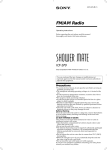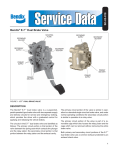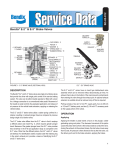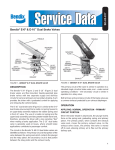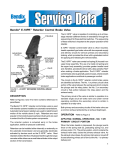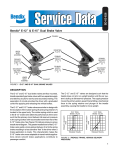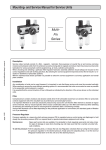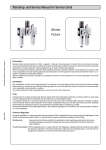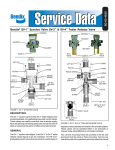Download BENDIX BW1565 User's Manual
Transcript
SD-03-816 ® Bendix® E-5™ Brake Valve 12 13 10 9 7 6 11 8 5 1 4 2 3 FIG. 1 FIG. 2 DESCRIPTION Balanced The Bendix® E-5™ brake valve is a single circuit brake valve that provides the driver with single point control of the service brake system. The valve is a suspended pedal operated valve, normally mounted on the engine firewall within the vehicle cab. Porting consists of 7 supply ports, 4 delivery ports, and one (1) 1/8 in. P.T. auxiliary supply port. Additional identified delivery and supply ports serve as a manifold for accessory devices. The exhaust port is equipped with a diaphragm. When air pressure in the cavity beneath the piston and the air pressure being delivered to the brake actuators equals the mechanical force on the top of the piston, the piston lifts and the inlet valve closes, stopping any further flow of air from the supply line through the valve. The exhaust remains closed, preventing any escape of air through the exhaust port. OPERATION Applying Applying the pedal exerts a force on the plunger, through the rubber graduating spring and to the piston. The piston moves and its stem, which is the exhaust seat, closes the exhaust. As the exhaust closes, the inlet valve moves off its seat. Air pressure from the reservoir then flows in by the inlet valve and out the delivery ports to the air chambers applying the brakes. When brake applications are made in the graduation range, the valve reaches a balanced position as the air pressure beneath the piston equals the effort exerted by the driver’s foot on the pedal. When the piston is fully depressed, the inlet valve remains open and reservoir pressure is delivered to the air chambers. Releasing If the pedal application is released and mechanical force is removed from the top of the piston, the force produced by the air pressure beneath the piston is then greater, and the piston lifts, opening the exhaust in the valve. The air below the piston and in the delivery lines is then exhausted through the exhaust port. PREVENTIVE MAINTENANCE Important: Review the warranty policy before performing any intrusive maintenance procedures. An extended warranty may be voided if intrusive maintenance is performed during this period. Because no two vehicles operate under identical conditions, maintenance and maintenance intervals will vary. Experience is a valuable guide in determining the best maintenance interval for any one particular operation. Visually check for physical damage to the brake valve such as broken air lines and broken or missing parts. Every 3 Months, 25,000 Miles or 900 Operating Hours Lubricate all pedal actuation parts with light (10W) oil. Check free pedal travel. If necessary, adjust stop button so that roller just contacts plunger. SERVICE TESTS Operating Test NOTE: IMPORTANT!!! Tests should be conducted with an accurate test gauge. Install gauge in a delivery port or line; depress the treadle or pedal to several positions between fully released and fully applied positions, checking the delivery pressure on the gauge to see that it varies proportionately with the movement of the treadle or pedal. In the fully applied position, the reading on the gauge should be approximately that of full reservoir pressure. Upon release of the application, the reading of the test gauge should fall to zero psi immediately. Leakage Test With 100 psi supply pressure and valve in released position, coat exhaust port with soapsuds and check for leakage. NO leakage permitted. Fully apply valve and hold application. Coat exhaust port with soapsuds. NO leakage permitted. Coat area around plunger and valve body with soapsuds. NO leakage permitted. For removal of internal parts only - remove the pedal and mounting plate assembly. Press up on the valve retainer and release the locking tabs from the body (CAUTION: piston is spring loaded); piston assembly, inlet valve seat, and the inlet/exhaust valve assembly may now be removed from the valve body. Installing Clean air lines to valve. Install valve and tighten mounting nuts and cap screws. Connect air lines to valve (plug any unused ports). Test valve as outlined under “Service Tests.” DISASSEMBLY Pedal and Mounting Plate 1. Remove cotter pin from fulcrum pin (1) and remove fulcrum pin and pedal. 2. Remove cotter pin from roller pin (2), remove roller pin. Remove pedal cover (3). 3. Remove mounting plate cap screws (4). Remove mounting plate with plunger. Plunger, stop button, and stop button lock nut may now be removed from mounting plate. Basic E-5™ Brake Valve 4. Depress retainer (5) and release retainer tabs from body grooves. Remove retainer. (CAUTION: Piston (6) is loaded by return spring (7).) 5. Remove piston assembly (6) and piston return spring (7). 6. Remove inlet seat (8). Remove o-rings from the inlet seat. 7. Remove inlet/exhaust valve (9) and spring (10). 8. Remove o-ring (11) from piston assembly (6). Remove cap screw, washer, spring seat, and rubber spring from piston. 9. Remove inlet valve stem o-ring (12) and valve retainer from inlet/exhaust valve assembly. 10. Remove exhaust check valve diaphragm (13). Cleaning and Inspection If the valve does not function as described or leakage is excessive, it is recommended that it be replaced with a new or remanufactured unit, or repaired with genuine Bendix parts available at Bendix outlets. 1. Wash all metal parts in mineral spirits and dry. Wipe all rubber parts clean. 2. Inspect all parts for excessive wear or deterioration. 3. Inspect valve and valve seats for nicks and burrs. REMOVING AND INSTALLING Removing Block and hold vehicle by means other than air brakes. Drain air brake system. For complete valve removal - disconnect all air lines in the cab and at the firewall from the brake valve. Remove mounting nuts and cap screws; remove valve. 2 4. Check springs for cracks, distortion or corrosion. 5. Inspect bore of body for scratches or out of round condition. Replace as necessary. 6. Inspect all pedal parts and mounting plate for wear; replace as necessary. Replace all parts not considered serviceable. It is recommended that all rubber parts be replaced. Maintenance Kits containing all necessary detail parts are available from Bendix outlets. Consult the Bendix catalog for piece numbers. ASSEMBLY Basic E-5™ Brake Valve 1. Lightly lubricate body bores, inlet/exhaust valve stem, o-rings, inlet seat, and piston with Dow Corning 55-M pneumatic grease (Bendix piece number 291126). 2. Install rubber spring in piston (as shown in illustration); install seat (with convolution towards rubber spring) on rubber spring. Install washer and cap screw. Torque cap screw to 50 inch pounds. 3. Install piston o-ring (11) on piston assembly. 4. Install valve retainer and stem o-ring on inlet/exhaust valve assembly. 5. Install inlet valve spring (10) in body; install inlet/exhaust valve assembly (9) in bore of body. 6. Instal o-rings on inlet valve seat (8) and install in body so tab in seat lines up with its slot in the body. 7. Install piston return spring (7) in inlet seat. 8. Install piston assembly (6); while exerting pressure on piston, install retainer (5); make certain retainer tabs snap into place in grooves of body. Pedal and Mounting Plate 9. Lightly lubricate plunger, plunger bore, fulcrum, roller pins, and all pedal actuation contact points with Molybdenum Disulfide grease (Bendix piece number 239378). 10. Install stop button and lock nut in mounting plate. 11. Install rollers on pedal with roller pin, secure pin with cotter pin. 12. Connect pedal to mounting plate with fulcrum pin (1); secure fulcrum pin with cotter pin. 13. Install plunger in mounting plate; install pedal cover (3). 14. Attach pedal/mounting plate assembly to valve body with cap screws (4). Torque cap screws to 80-120 inch pounds. 15. Adjust free pedal travel so that the rollers just contact the plunger by adjusting the stop button. Tighten lock nut when adjustment is complete. Testing Rebuilt E-5™ Brake Valve Perform Operating and Leakage Tests as outlined in “Service Test” section. WARNING! PLEASE READ AND FOLLOW THESE INSTRUCTIONS TO AVOID PERSONAL INJURY OR DEATH: When working on or around a vehicle, the following general precautions should be observed at all times. 1. Park the vehicle on a level surface, apply the parking brakes, and always block the wheels. Always wear safety glasses. 2. Stop the engine and remove ignition key when working under or around the vehicle. When working in the engine compartment, the engine should be shut off and the ignition key should be removed. Where circumstances require that the engine be in operation, EXTREME CAUTION should be used to prevent personal injury resulting from contact with moving, rotating, leaking, heated or electrically charged components. 3. Do not attempt to install, remove, disassemble or assemble a component until you have read and thoroughly understand the recommended procedures. Use only the proper tools and observe all precautions pertaining to use of those tools. 4. If the work is being performed on the vehicle’s air brake system, or any auxiliary pressurized air systems, make certain to drain the air pressure from all reservoirs before beginning ANY work on the vehicle. If the vehicle is equipped with an AD-IS™ air dryer system or a dryer reservoir module, be sure to drain the purge reservoir. 5. Following the vehicle manufacturer’s recommended procedures, deactivate the electrical system in a manner that safely removes all electrical power from the vehicle. 6. Never exceed manufacturer’s recommended pressures. 7. Never connect or disconnect a hose or line containing pressure; it may whip. Never remove a component or plug unless you are certain all system pressure has been depleted. 8. Use only genuine Bendix ® replacement parts, components and kits. Replacement hardware, tubing, hose, fittings, etc. must be of equivalent size, type and strength as original equipment and be designed specifically for such applications and systems. 9. Components with stripped threads or damaged parts should be replaced rather than repaired. Do not attempt repairs requiring machining or welding unless specifically stated and approved by the vehicle and component manufacturer. 10. Prior to returning the vehicle to service, make certain all components and systems are restored to their proper operating condition. 3 BW1565 © 2004 Bendix Commercial Vehicle Systems LLC. All rights reserved. 3/2004 Printed in U.S.A.




